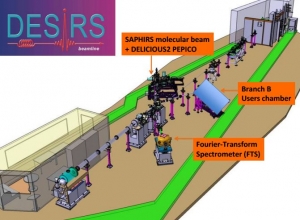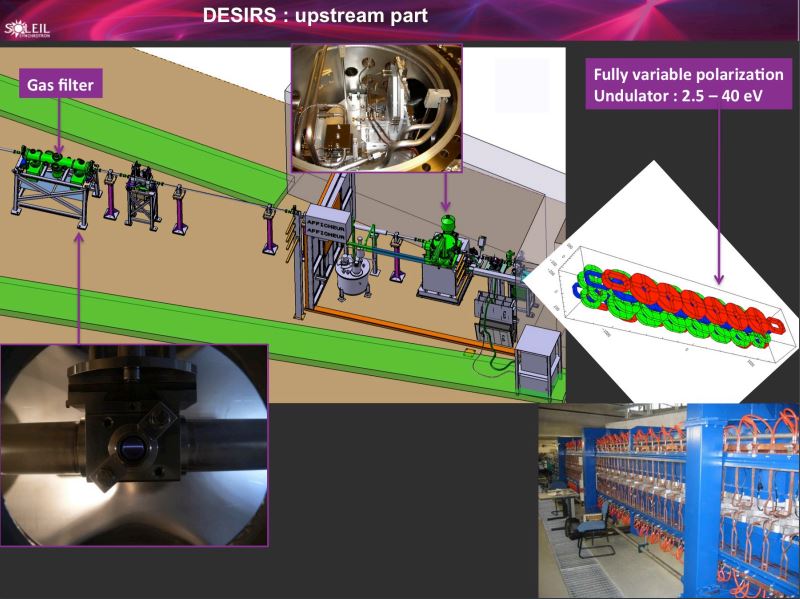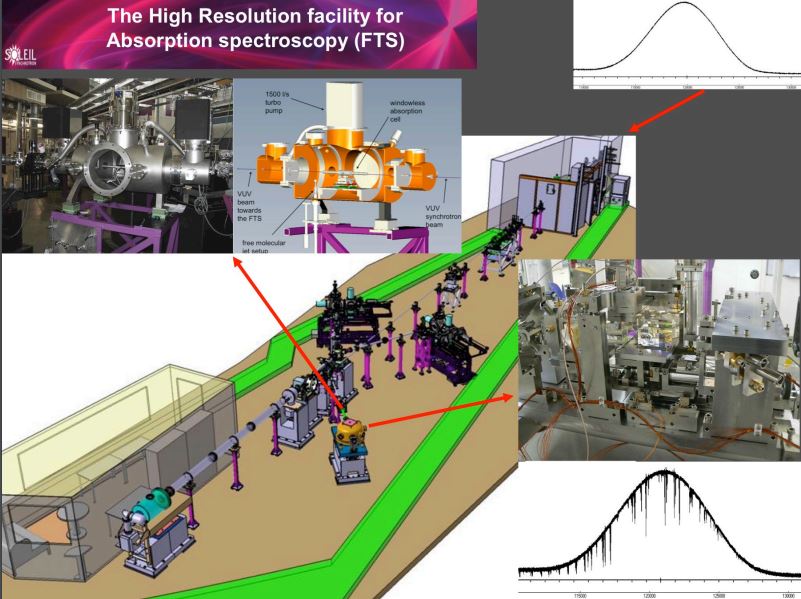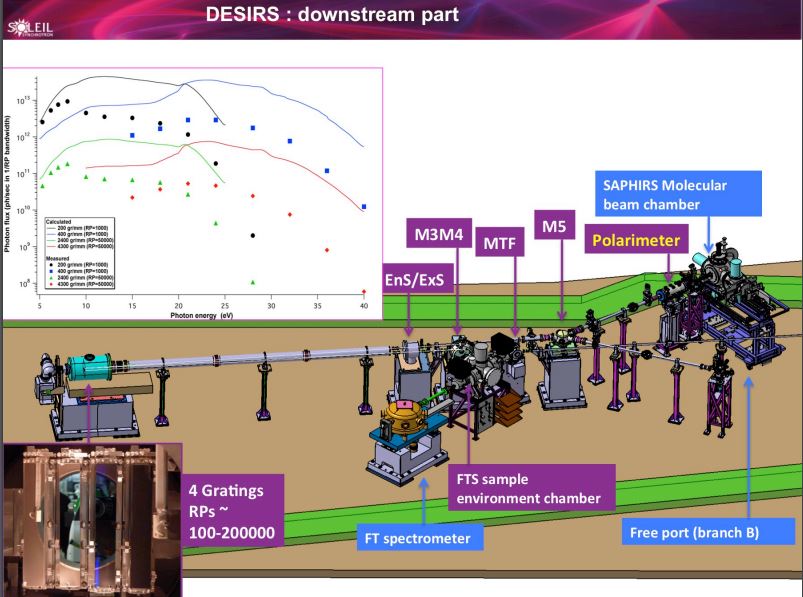
DESIRS (Dichroïsme Et Spectroscopie par Interaction avec le Rayonnement Synchrotron) is an undulator-based beamline covering the VUV range (5-40 eV) with a unique combination of ultra high resolution spectral purity, flux and fully variable polarization.
 DESIRS (Dichroïsme Et Spectroscopie par Interaction avec le Rayonnement Synchrotron) is an undulator-based beamline covering the VUV range (5-40 eV) with a unique combination of ultra high resolution spectral purity, flux and fully variable polarization.
DESIRS (Dichroïsme Et Spectroscopie par Interaction avec le Rayonnement Synchrotron) is an undulator-based beamline covering the VUV range (5-40 eV) with a unique combination of ultra high resolution spectral purity, flux and fully variable polarization.
DESIRS provides new opportunities for the study of photon-induced processes via the valence shell on mainly isolated gas phase samples, such as cold molecules, radicals, laser-excited species, biomolecules, large ionic biopolymers, clusters and nanoparticles, as well as on condensed matter. This includes high resolution spectroscopy, molecular dynamics and reactivity, and photoionization dynamics studies. In addition, the availability of calibrated versatile (linear, circular) polarisations of the photon beam is a unique specificity of the beamline allowing the study of molecular chirality and anisotropic properties of matter via different types of dichroism experiments.
Note also that the research carried out on DESIRS takes place within the framework of the “Gas phase, atmosphere, universe” scientific section of SOLEIL.
Team
Technical data
5 – 40 eV (2500 Å – 300Å)
Δλ = 33 mÅ, 60 mÅ and 720 mÅ for 100 μm slits depending on the grating. Ultimate Resolving Power ~ 200000 @16 eV, ~ 100000 @21 eV
Up to 1000000 @ 20 eV with FT-spectrometer in absorption
Electromagnetic planar/helicoidal undulator OPHELIE2 (HU640) : 14 periods of 640 mm
Fully variable, including rotatable linear and circular polarizations. In situ polarization calibration with a VUV dedicated polarimeter
up to 0.5 Hz in the Dichroism AC mode (in 2017)
~1010 to 1014 ph/sec depending on the energy and the bandpass. ~1015Ph/sec in 7% bandwidth at the zeroth order
~ 70 μm*(exit slit) (V) x ~200 μm (H)
Fully-harmonics-free radiation owing to a gas filter (up to 21 eV) and optics cut-off above 21 eV.
Scientific opportunities
| Physical-Chemistry |
|
|---|---|
| Atmospheric chemistry |
|
| Physics |
|
| Optics |
|
| Astrophysics |
|
| Organic chemistry, astrobiology & biology |
|
| Condensed matter |
|
The beamline possesses 3 different branches and 2 endstations available for users.

The 3 branches are connected to a common white-light branch (Undulator + first optics) equipped with a gas filter that totally suppresses the high harmonics of the undulator

Publication :
Fourier-Transform absorption spectroscopy branch (FTS)

The High Resolution facility for Absorption spectroscopy (FTS) : ![]() desirs_bl2.pdf (230.1 KB)
desirs_bl2.pdf (230.1 KB)
This branch is equipped with a unique newly designed FT-spectrometer covering the range from 5 to 30 eV with an unprecedented instrumental linewidth down to 0.08 cm-1 for such a multiplex instrument (corresponding to a resolving power of up to 1000000 @ 10 eV). The resolution can be easily adjusted for absorption spectroscopy requiring high S/N and moderate spectral resolution. (Plan :![]() branche_fts.pdf (540.38 KB) | Publication:
branche_fts.pdf (540.38 KB) | Publication: ![]() ndo_naturephotonics2011_fts.pdf (1.07 MB) | FTS instruction manual:
ndo_naturephotonics2011_fts.pdf (1.07 MB) | FTS instruction manual:
A sample environment chamber located just upstream includes:
- LN2-cooled windowless absorption gas cell (100 to 300 K, column density up to 1017 cm-2)
- heated windowless gas cell (up to 1000 K)
- several windowed absorption cells of various lengths for absolute cross sections measurement and/or high column densities. One of them is equipped with a DC discharge for the production of radicals.
- a free molecular beam (rotational cooling down to 20 K column density up to 1015 cm-2).
A full description of the sample environment chamber and associated methologies is available in this![]() publication (1.11 MB)
publication (1.11 MB)
2 monochromatized branches (Branch A and B)

2 monochromatized branches (Branch A and B) : to perform any type of spectroscopy or dichroism experiments with an optimized resolution/flux compromise ensured by the use of 4 gratings (4300 gr/mm, 2400 gr/mm, 400 gr/mm and 200 gr/mm) (typically 1010-1011ph/sec for RP of 100000 up to 1013-1014 ph/sec for a RP of 100), and variable polarization (linear horizontal, vertical as well as left- and right-handed circular polarization mode (CPL) fully calibrated owing to a
In the pure CPL mode, the absolute polarization rate, as measured at the sample location, is above 97 % over the whole VUV range.
On branch A is installed a multipurpose molecular beam chamber, SAPHIRS, consisting of a source chamber and an ionizationchamber separated by a skimmer. In the later is installed a versatile double imaging electron/ion coincidence spectrometer(i2PEPICO), DELICIOUS3, combining a Velocity Map Imaging spectrometer (VMI) to a Wiley-McLaren TOF 3D momentum imaging ionspectrometer. DELICIOUS3 allows in the fast electron mode to perform Angle-Resolved Photoelectron Spectroscopy (AR-PES) on mass-selected and KER-selected samples, with electron energy resolution down to 4 %, and in the slow electron mode to record Threshold PES (TPES) and TPEPICO with meV or sub-meV resolution. In both cases the mass resolution reaches 300 (full peak separation) and up to 800 (FWHM separation). The ion momentum resolution is in the 10-15 % range. (Article:
SAPHIRS’s source chamber is equipped with various sample environments:
- a simple nozzle for gaseous samples, or highly-volatile liquid ones introduced via a cooled or heated bubbler.
- a nozzle equipped with a flash-pyrolysis unit allowing the production of radicals from gaseous precursors
- an oven (coupled to a nozzle) that can be heated up to 700 K for handling liquid or solid samples to be seeded with a carrier gas before expansion
- a flow tube coupled to a MW discharge to produce radicals as well as identifying and monitoring in time radical-neutrals products
- an aerodynamical lens to carry and focus into the ionization chamber sub-nm and nm nanoparticles/aerosols as produced ex-situ or via an atomizer. This set-up can be used alone (for photoemission studies of nanoparticles) or with a thermodesorber (a hot tip located close to the ionization volume) releasing in the gas phase the molecules constituting the aerosol. (Article: )
 bioaerosols_pccp2011.pdf (2.41 MB - pdf) (2.41 MB)Media Folder:
bioaerosols_pccp2011.pdf (2.41 MB - pdf) (2.41 MB)Media Folder:
A recently-added differentially-pumped double skimmer chamber described in this![]() publication (2.89 MB) that can be aligned in-vacuum, has increased the maximum working pressure in the main source chamber to a few torrs. In addition, the double skimmer has narrowed the molecular beam profile so that the particle kinetic energy resolution has been improved, as well as the cation mass resolution, which has been multiplied by x1.5.
publication (2.89 MB) that can be aligned in-vacuum, has increased the maximum working pressure in the main source chamber to a few torrs. In addition, the double skimmer has narrowed the molecular beam profile so that the particle kinetic energy resolution has been improved, as well as the cation mass resolution, which has been multiplied by x1.5.
Branch B is a free port on which any user experiments can be connected, via a differential pumping stage. The focal point is located 350 mm downstream the last UHV valves, and the beam divergence at the focal point is typically of the order of 5.5 mrad (V) x 3.5 mrad (H). The height of the beam with respect to the ground is 1550 ± 10 mm. The available space on the beamline for experiments to be connected to branch B can be seen here in 2D (
Besides the possibility to connect any external user experiments on branch B, this branch also hosts two associated experiments which are available to all users:
CERISES, allowing the study of the reactivity of state-selected ions (including now radical cations) with neutrals. (Article:
SRMS2, an ion trap coupled to DESIRS allowing the study of VUV photodynamics & proteiomics on electro-sprayed biopolymers multi-charges ions (cations or anions). (Article:


